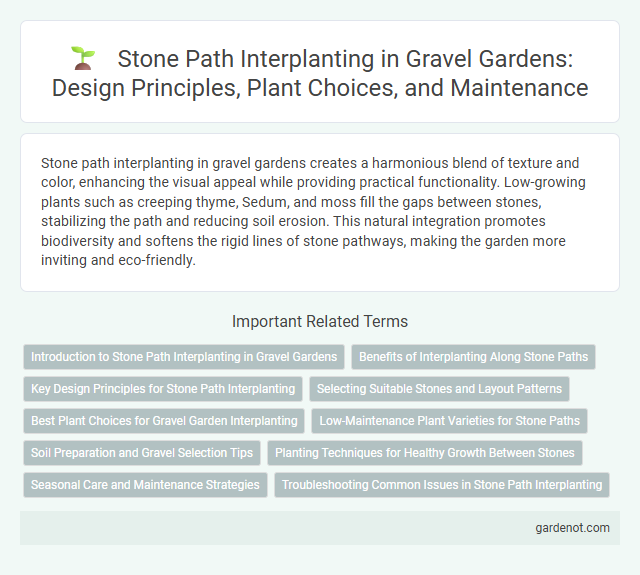Stone path interplanting in gravel gardens creates a harmonious blend of texture and color, enhancing the visual appeal while providing practical functionality. Low-growing plants such as creeping thyme, Sedum, and moss fill the gaps between stones, stabilizing the path and reducing soil erosion. This natural integration promotes biodiversity and softens the rigid lines of stone pathways, making the garden more inviting and eco-friendly.
Introduction to Stone Path Interplanting in Gravel Gardens
Stone path interplanting in gravel gardens enhances both aesthetics and functionality by integrating low-growing, drought-tolerant plants between pavers. This approach promotes soil stability and weed suppression while creating a natural, cohesive landscape design. Popular choices include creeping thyme, sedum, and blue star creeper, which thrive in well-drained, sunny conditions.
Benefits of Interplanting Along Stone Paths
Interplanting along stone paths in gravel gardens enhances soil stability by reducing erosion and improving water infiltration. Native groundcovers and drought-tolerant plants create natural weed suppression while adding vibrant textures and colors that soften the hardscape. These plantings support pollinators and beneficial insects, promoting a balanced ecosystem within gravel garden environments.
Key Design Principles for Stone Path Interplanting
Stone path interplanting enhances gravel gardens by incorporating low-growing, drought-tolerant plants like sedum, thyme, and creeping phlox between stepping stones, improving both aesthetics and functionality. Key design principles include selecting plants with resilient root systems that withstand foot traffic and ensuring adequate spacing to prevent overcrowding and maintain path visibility. Integrating varied textures and colors promotes visual interest while supporting soil stability and drainage along the stone pathway.
Selecting Suitable Stones and Layout Patterns
Selecting suitable stones for a gravel garden stone path involves considering durability, size, and texture to ensure stability and aesthetic appeal. Common choices include flagstone, slate, and bluestone, which provide a natural look while withstanding foot traffic. Layout patterns such as running bond, random, and herringbone optimize both functionality and visual interest, enhancing the garden's overall design.
Best Plant Choices for Gravel Garden Interplanting
Best plant choices for stone path interplanting in gravel gardens include drought-tolerant varieties such as thyme (Thymus spp.), sedum, and creeping phlox (Phlox subulata), which thrive in well-drained soil and resist foot traffic. Low-growing, hardy perennials like blue fescue (Festuca glauca) and ajuga offer vibrant color and texture while minimizing weed growth. These plants improve aesthetic appeal and contribute to soil stabilization, enhancing the durability and usability of stone path surfaces in gravel garden designs.
Low-Maintenance Plant Varieties for Stone Paths
Low-maintenance plant varieties for stone path interplanting in gravel gardens include creeping thyme, sedum, and blue star creeper, which thrive in well-drained conditions and require minimal watering. These plants enhance the aesthetic appeal by filling gaps between stones with lush greenery and vibrant blooms while preventing weed growth. Their drought tolerance and resistance to foot traffic make them ideal choices for sustainable, attractive stone pathways.
Soil Preparation and Gravel Selection Tips
Effective soil preparation for a gravel garden stone path involves ensuring proper drainage and nutrient balance by amending the soil with organic matter and sand to prevent compaction. Selecting gravel with a mix of angular and rounded stones, typically 8-12mm in size, enhances stability and provides a natural appearance while minimizing weed growth. Incorporating low-growing, drought-tolerant plants such as thyme or sedum between stones boosts aesthetic appeal and supports soil health.
Planting Techniques for Healthy Growth Between Stones
Interplanting in a stone path requires selecting drought-tolerant, low-growing plants like thyme, sedum, or creeping phlox to thrive in minimal soil conditions and withstand foot traffic. Soil preparation with well-draining, sandy substrate and regular mulching ensures adequate moisture retention and prevents compaction. Strategic planting techniques include spacing plants to allow root expansion while maintaining accessibility, promoting healthy growth between stones and enhancing the gravel garden's aesthetic appeal.
Seasonal Care and Maintenance Strategies
Stone path interplanting in gravel gardens requires seasonal care to ensure plant health and aesthetic appeal. Spring demands pruning and removal of dead foliage to promote growth, while summer irrigation must balance moisture without oversaturation, especially for drought-tolerant species like sedum and thyme. In autumn, clearing fallen leaves prevents mold and decay, and winter protection includes mulching to shield roots from frost damage.
Troubleshooting Common Issues in Stone Path Interplanting
Stone path interplanting often faces challenges such as poor plant establishment due to insufficient soil depth and inadequate drainage, leading to root rot or plant stress. Weed invasion is another common issue, requiring regular maintenance and use of appropriate ground covers or mulch to suppress unwanted growth. Ensuring the selection of drought-tolerant, sun-loving plants that thrive in gravel environments can prevent plant decline and maintain the garden's aesthetic appeal.
Stone path interplanting Infographic

 gardenot.com
gardenot.com